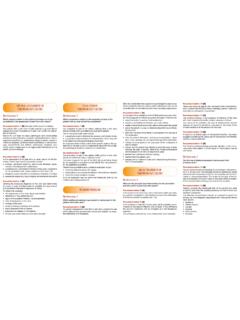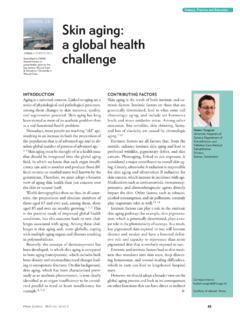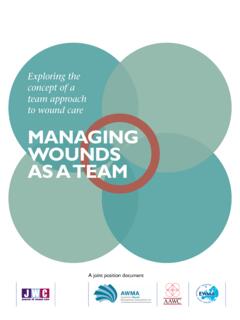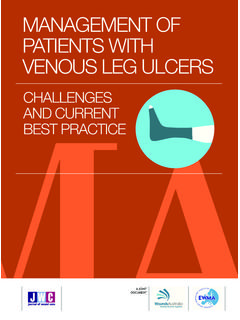Transcription of MANAGEMENT OF PATIENTS WITH VENOUS LEG ULCERS …
1 MANAGEMENT OF. PATIENTS with . VENOUS LEG ULCERS . CHALLENGES. AND CURRENT. BEST PRACTICE. A JOINT. DOCUMENT. Peter J Franks1 (Editor), PhD, Professor of Health Sciences and Director Judith Barker2 (Co editor), RN, NP, STN, BHlth Sci (Nurs), MN(NP). Mark Collier3, Nurse Consultant - Tissue Viability Georgina Gethin4, PhD, Pg Dip Wound Healing, RGN, FFNMRCSI. A/Head of School Emily Haesler5 PhD, BN, P Grad Dip Adv Nurs (Gerontics), Consultant Researcher Arkadiusz Jawien6 MD, PhD, Professor, Head of Department Severin Laeuchli7, Dr. med., Chief of Dermatologic Surgery, President of the European Wound MANAGEMENT Association (EWMA). Giovanni Mosti8, MD, Head of Angiology Department Sebastian Probst9, DClinPrac, RN, Professor of Wound Care Carolina Weller10, PhD, GCHE Med (Research), BN, NHMRC Public Health Fellow, Senior Research Fellow 1.
2 Centre for Research & Implementation of Clinical Practice, 128 Hill House, 210 Upper Richmond Road, London SW15 6NP, United Kingdom 2. Wounds Australia 3. United Lincolnshire Hospitals NHS Trust (ULHT), c/o Pilgrim Hospital, Sibsey Road, Boston, Lincolnshire, PE21 9QS, United Kingdom. 4. School of Nursing and Midwifery, NUI Galway, Ireland 5. Wound MANAGEMENT and Healing Node, Curtin University, Perth, Australia & Academic Unit of General Practice, Australian National University, Canberra, Australia (Visiting Fellow). 6. Department of Vascular Surgery and Angiology, Collegium Medicum, University of Nicolaus Copernicus, Bydgoszcz, Poland 7. University Hospital Z rich, Department of Dermatology, Gloriastrasse 31, CH-8091 Z rich, Switzerland 8. Barbantini Clinic, Via del Calcio , Lucca, Italy 9.
3 School of Health, University of Applied Sciences Western Switzerland, HES-SO Gen ve, Avenue de Champel 47, CH-1206. Geneva, Switzerland 10. Department of Epidemiology and Preventive Medicine, School of Public Health and Preventive Medicine, Monash University, 99 Commercial Road, Melbourne VIC 3004, Australia Editorial support and coordination: Julie Bjerregaard, EWMA Secretariat Corresponding authors: Editor, Peter J Franks, Co-editor, Judith Barker, The document is supported by an unrestricted grant from: Activa Healthcare, BSN Medical, Lohmann & Rauscher, Urgo and Welcare. This article should be referenced as: Franks, P., Barker, J., Collier, M. et al. MANAGEMENT of PATIENTS with VENOUS leg ulcer : challenges and current best practice, J Wound Care, 25; 6, Suppl, 1 67. EWMA 2016. All rights reserved.
4 No reproduction, transmission or copying of this publication is allowed without written permission. No part of this publication may be reproduced, stored in a retrieval system, or transmitted in any form or by any means, mechanical, electronic, photocopying, recording, or otherwise, without the prior written permission of the European Wound MANAGEMENT Association (EWMA) or in accordance with the relevant copyright legislation. Although the editor, MA Healthcare Ltd. and EWMA have taken great care to ensure accuracy, neither MA Healthcare Ltd. nor EWMA will be liable for any errors of omission or inaccuracies in this publication. Published on behalf of EWMA by MA Healthcare Ltd. Publisher: Anthony Kerr Editor: Rachel Webb Designer: Milly McCulloch Published by: MA Healthcare Ltd, St Jude's Church, Dulwich Road, London, SE24 0PB, UK.
5 Tel: +44 (0)20 7738 5454 Email: Web: S2 J O U R N A L O F WO U N D C A R E VO L 2 5 N O 6 E W M A D O C U M E N T 2 0 1 6. Contents Abbreviations 4 Clinical practice statements 35. The role of dressings in VENOUS leg ulcer MANAGEMENT 36. 1. Introduction 6. Clinical practice statements 38. Background 6. Invasive treatments 39. Document focus and aims 7. Clinical practice statements 41. Target population 7. Referral structures 43. 2. Methodology 8 Managing PATIENTS with VENOUS leg ULCERS between primary Guideline consensus 8 and secondary health-care settings 43. Literature search 8 The multidisciplinary team in VENOUS leg ulcer 3. Overview and comparison of available guidelines 10 MANAGEMENT 43. Identifying and comparing guidelines 10 Clinical practice statements 46. Guideline comparison: results 10 Secondary prevention 47.
6 Key points/summary of findings 14 Need for services/education in place to monitor PATIENTS with a healed VENOUS leg ulcer 47. 4. Clinical adherence to guidelines: barriers and facilitators 16. A VENOUS leg ulcer has healed: what next? 47. Introduction 16. The health-care system/organisation: the payer and Clinical practice statements 49. provider perspective 17 Monitoring outcome 49. Reimbursement of PATIENTS and health-care Relevant endpoints in VENOUS leg ulcer studies 50. organisations 17 Patient-centred outcomes 51. Pursuing cost-effective care 18 Clinical practice statements 52. ehealth as a facilitator for implementation/ 6. Conclusion 53. integrated care 19 References 55. MANAGEMENT support 20 Appendix 1: literature search strategy: guideline implementation 62. H. ealth-care professionals: barriers and facilitators 20 Search 1: general facilitators or barriers for implementation 62.
7 Patient: related barriers and facilitators 22 Search 2: specific on guidelines on chronic wounds 62. Conclusion 23 Search 3: specific on leg ulcer guidelines 62. 5. Current best practice leg ulcer MANAGEMENT : clinical Appendix 2: literature search strategy: VENOUS leg ulcer practice statements 24 MANAGEMENT 64. Introduction 24 Search 1: definition 64. Differential diagnosis and assessment 24 Search 2: assessment and diagnosis 64. Key characteristics of different aetiologies: how to Search 3: treatment delivery / MANAGEMENT 64. differentiate 24 Search 4: monitoring outcomes 64. Patient assessment and vascular assessment 26 Search 5: referral structures 65. Local ulcer assessment 31 Search 6: secondary prevention 65. Clinical practice statements 33 Search 7: PATIENTS ' perspective 65. Treatment delivery 33 Search 8: organisation 65.
8 Non-invasive treatments 34 Search 9: health economics 65. Appendix 3: diagnosis and assessment of atypical leg ULCERS 66. J O U R N A L O F WO U N D C A R E VO L 2 5 N O 6 E W M A D O C U M E N T 2 0 1 6 S3. Abbreviations AAWC: Association for the Advancement of CRP: C-reactive protein Wound Care CVI: Chronic VENOUS insufficiency ABI: Ankle brachial index CVD: chronic VENOUS disease ABPI: Ankle brachial pressure index CWIS: Cardiff Wound Impact Schedule ANA: Anti-nuclear antibodies CXVUQ: Charing Cross VENOUS Ulceration ANCA: Anti-neutrophil cytoplasm antibodies Questionnaire ASVAL: Ambulatory selective varicose vein EDF: European Dermatology Forum ablation under local anaesthesia ESR: Erythrocyte sedimentation rate AVCD: Self Adjustable Velcro Compression Devices ESVS: European Society for Vascular Surgery AVF: The American VENOUS Forum EU: European Union AVVQ : Aberdeen Varicose Vein Questionnaire EVLT: Endovenous laser therapy BMI: Body mass index EWMA.
9 European Wound MANAGEMENT CEAP Classification: Clinical class (C), etiology Association (E), anatomical distribution of reflux (A) and obstruction in the superficial, deep and perforating FRS: FACES Pain Rating Scale veins, and the underlying pathophysiology (P). FPS: Functional Pain Scale CHIVA: Ambulatory conservative haemodynamic MANAGEMENT of varicose veins GP: General practitioner CIVIQ: Chronic VENOUS Insufficiency HCP: Health-care professional Questionnaire HYTILU: Hypertensive ischaemic leg ULCERS CoI: Conflict of interest (Martorell's ULCERS ). CPG: Clinical practice guideline ICT: Information and communication technology S4 J O U R N A L O F WO U N D C A R E VO L 2 5 N O 6 E W M A D O C U M E N T 2 0 1 6. LFT: Liver function tests RFA: Radiofrequency ablation LU: Leg ulcer SEPS: Subfascial endoscopic perforator surgery MMPs: Matrix metalloproteinases SIGN: Scottish Intercollegiate Guidelines Network MPQ : McGill pain questionnaire SVS: Society for Vascular Surgery MUST: Malnutrition universal screening tool TIME: Tissue MANAGEMENT , control of infection and inflammation, Moisture imbalance, MD: Medical Doctor Advancement of the epithelial edge of the NHG: Dutch college of general practitioners wound NRS: Nutrition Risk Screening UK: United Kingdom PAOD: Peripheral arterial occlusive disease US: United States (of America).
10 PN: Practice nurse VAS: Visual analogue scale QoL: Quality of life VEINES-QOL: VENOUS insufficiency epidemiological and economic study RCT: Randomised clinical trial VLU: VENOUS Leg ulcer RF/RhF: Rheumatoid factors J O U R N A L O F WO U N D C A R E VO L 2 5 N O 6 E W M A D O C U M E N T 2 0 1 6 S5. 1. Introduction Background PATIENTS not receiving appropriate and timely It is well documented that the prevalence of treatment in the initial development of VLUs, VENOUS leg ULCERS (VLUs) is increasing, coinciding effective MANAGEMENT of their VLU and preventing with an ageing population. Accurate global recurrence once the VLU has healed. prevalence of VLUs is difficult to estimate due to the range of methodologies used in studies Health-care professionals (HCPs) and organisations and accuracy of VENOUS ulceration must have confidence in the development process is the most common type of leg ulceration of clinical practice guidelines and have ownership and a significant clinical problem, affecting of these guidelines to ensure those of the highest approximately 1% of the population and 3% quality guide their practice.









